|

Example of five different
systems installed by us to solve radon problems:
These are examples as
every house is different and an optimal solution can be found depending
on the many details of your house. The first three examples are also
called Active Soil De-pressurization (ASD) systems and are based on the
principle that the radon is captured under a radon barrier -- The
barrier consists of the concrete basement slab that is hermetically
sealed, or an impermeable barrier to be installed in a crawlspace --
and guided via a vent pipe to above the roof line using an active
element in the form of a powerful, yet low noise in-line ventilator.
The fourth example is based on an entirely different principle as
explained. The fifth example shows how a crawlspace looks after the
radon barrier is installed.
1:
Interior Radon Mitigation System
In the case of an Interior System the pipe can be shielded from the
outside view and noise can be kept away from interior finished areas.
 In the
first picture the ventilator is in the attic of this home. The vent
pipe is here only visible as a small speck on the roof. The pipe
routing went from unfinished basement into the kitchen pantry (backside
wall) into the master bedroom closet (along backside wall) into the
attic and through the wood shake roof. The ventilator was placed in the
attic immediately under the roof as shown in the next picture. In the
first picture the ventilator is in the attic of this home. The vent
pipe is here only visible as a small speck on the roof. The pipe
routing went from unfinished basement into the kitchen pantry (backside
wall) into the master bedroom closet (along backside wall) into the
attic and through the wood shake roof. The ventilator was placed in the
attic immediately under the roof as shown in the next picture.
Interior System: Ventilator
and pipe optimally shielded from the view, outside and inside.
Or
the pipe can vent hidden through back side of garage roof 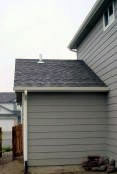
 Example how the
ventilator can be placed in the attic of the home. Example how the
ventilator can be placed in the attic of the home.
2:
Exterior Radon Mitigation System
 |
An Exterior Radon Mitigation System has the
ventilator on the outside of the home, preferably out of view from
street side and back sitting area because of visual and noise concerns.
These systems are not less effective in removing the radon than
interior systems but often allow a more cost effective approach at the
cost of the visual and noise impact of the system on the outside of the
house.
Exterior System: More
visible from the outside and somewhat more noisy than an interior system
|
3:
Super-Low-Noise Exterior Radon Mitigation System
|
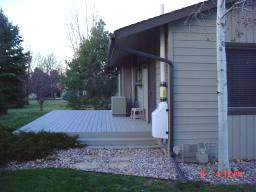
Click
photo to see more pictures of a Super Low Noise radon mitigation system.
|
This system was
developed by us for one of our customers. The noise that the
conventional exterior system (see example 2 above) made bothered her
next to the sitting area on the deck. The conventional exterior system
was inherited from the seller in the real estate transaction. The
current home owner requested to transform the system in a radon
mitigation system that gives the lowest-noise-possible. This became our
"Super-Low-Noise" option.
Super Low Noise
Exterior System: Minimizes noise in case the system has to be placed
outside near a deck or sitting area.
|
4:
Energy Recovery and Ventilation Radon Mitigation System
|
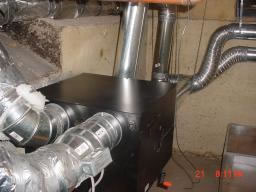
Energy Recovery
& Ventilation System
|
In the case of an
Energy Recovery and Ventilation systems the principle of the mitigation
is different from the conventional systems discussed above: A dilution
of radon concentration is caused by constantly bringing in fresh air
and removing stale air from basement or whole house. This is a good
option if the building also benefits from fresh air circulation, such
as in older buildings, buildings with odors in basement, or
inaccessibly low crawlspaces ("engineered", suspended wood floors in
basements, with a crawlspace equal or less than 2 feet high). Another
example is when the basement or area is used as office and there are
not a lot of windows and the area can use fresh air summer and winter.
|
5:
Crawlspace Radon Removal System
|
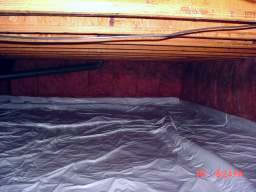
Click
photo to see more pictures before and after radon mitigation .
|
In the case of a 4
foot high crawlspace in your home a conventional radon mitigation
system (ASD) is installed (any one of the examples 1 through 3) in
combination with a collector system under this white special radon
barrier (black plastic is not a radon barrier) as is shown in various
pictures.
|
In the case of a 4 foot
high crawlspace in your home a conventional radon mitigation system
(ASD) is installed (any one of the examples 1 through 3) in combination
with a collector system under this white special radon barrier (black
plastic is not a radon barrier) as is shown in various pictures (click
photo for more pictures).
Radon Mitigation
Why use RHMM for
your radon mitigation needs:
 A fully certified person by
the National Environmental Health Association (NEHA) will do the Radon
Mitigation. A fully certified person by
the National Environmental Health Association (NEHA) will do the Radon
Mitigation.
 EPA
standards and procedures will be followed. EPA
standards and procedures will be followed.
 We have
mitigated all types of homes including: We have
mitigated all types of homes including:
- Two story
homes with finished and unfinished basements.
- Ranch with full
finished and unfinished basements, and crawlspace.
- Tri-level homes with
partial crawlspace.
- New and Old homes.
- Businesses and
commercial properties
 Typically we obtain results
below 1.5 pCi/L after our mitigation is done. Typically we obtain results
below 1.5 pCi/L after our mitigation is done.
 We work
professionally and clean. After the mitigation work is over, apart from
a system that is installed appropriately hidden in your home, there is
hardly any tell tale signal that we worked in your home. We work
professionally and clean. After the mitigation work is over, apart from
a system that is installed appropriately hidden in your home, there is
hardly any tell tale signal that we worked in your home.
 Our systems
are always designed to incorporate your wants and needs in them: Our systems
are always designed to incorporate your wants and needs in them:
- We will find the best
solution
- We will find a solution
with the least visible changes to your home, so you do not have to worry
about loss of value and extra stress when reselling your home.
- Sometimes we will be
able to propose a very economical solution depending on the special
configuration of your home. This is why we want to personally visit
your home to inspect
whether there are such possibilities that are still consistent with the
EPA-standards.
Here we show some of the
special tools needed to install a radon mitigation system:
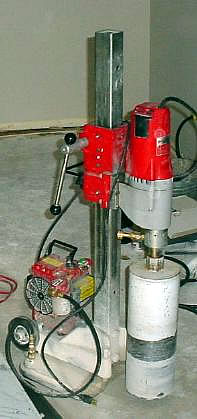 |
Shown to the left is
a water cooled and flushed diamond core drill to core holes of
appreciable size. The water flushing minimizes the generation of dust
in your house and helps cool the drill.
Cores drilled from
concrete basement slabs with the diamond core drill:
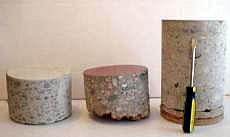
Most
concrete slabs are four inches thick, but there are exceptions as shown
here
|
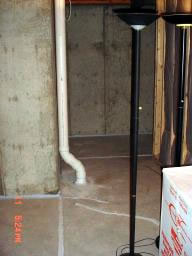 |
When we have
finished preparing the hole for radon mitigation and the sub slab
de-pressurization communication test a large diameter PVC pipe is
attached via a perfect match to the hole with the appropriate bushing
to prevent air leakage around the edges. This makes the system low
noise and gives it the look as if the system was built-in during the
original construction of the building. In this picture it can also be
recognized how all reachable expansion joints, cracks and grooves in
the entire basement are caulked with a liberal amount of caulk
following the EPA recommendations.
|
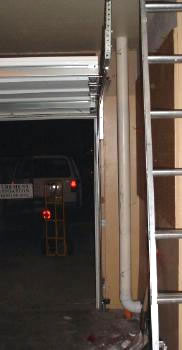 |
Depending on the
location of the fan, sometimes a vertical pipe section will have to be
visible in a garage. It is kept close to the wall and placed where it
is hardly noticeable:
|
Guaranteed
low radon result after mitigation using the SSDC-tests.
Special methods and instruments during the job help us to ensure a
guaranteed low radon concentration in the end. As and example we show
here a special highly sensitive pressure manometer to perform sub-slab
de-pressurization communication (SSDC) tests to be able to tell the home
owner whether the ventilator system reaches under the entire slab or
only a part of it. As shown in these pictures these tests can be done
as soon as the radon extraction hole is drilled with our core drill and
is prepared for the radon mitigation by using the same in-line
ventilator that is eventually used for the radon mitigation. Some
companies use a vacuum cleaner to create the suction power for this
test, but a vacuum cleaner has different characteristics than this
ventilator therefore the result with a vacuum cleaner is not always
reliable. Our test using the ventilator that will be installed has been
shown to be reliable indicator.
 |
The
appropriate ventilator is placed in the bushing for the SSDC-tests: |
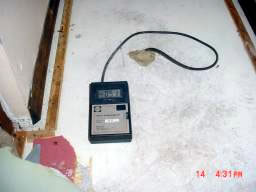 |
This sensitive
manometer test is part of the SSDC-test that can indicate during the
day of installation whether the house will be mitigated below the
action level. |
As an added benefit this
allows us to make adjustments to optimize the system during
installation if doubts exist.
In the example shown the level came out low after performing the EPA
48-hour radon test: The house was mitigated from an original level of
15.5 to 1.4 pCi/L
Traveling
the distance to your home
Most mitigations can be done in 1 or 2 days. We are completely ready to
travel a distance. With a Cargo Van and Trailer we can handle tools and
materials for almost any radon job within reasonable distance. This
allows you to get the radon expertise you need to solve your radon
problem right at your home. We are also committed to communicate with
you by e-mail or phone about any questions you might have about the
mitigation system after the installation was completed.
<<
back to top
<< Previous
[Radon Measurements] Next
[Real Estate Transactions] >> Next
[Real Estate Transactions] >>
|















